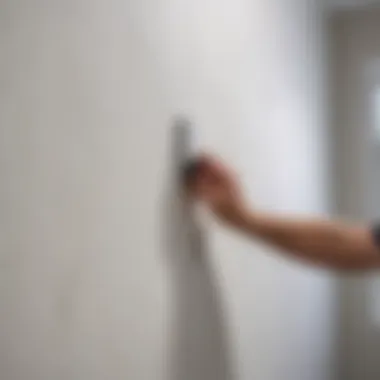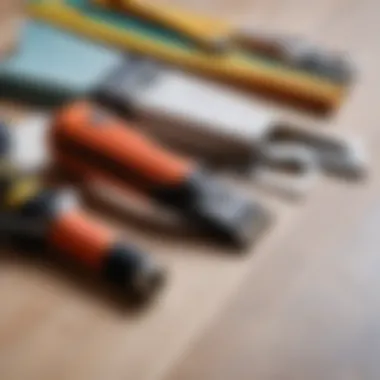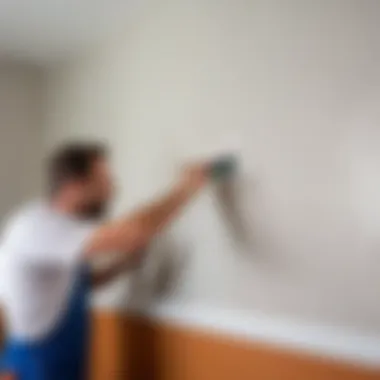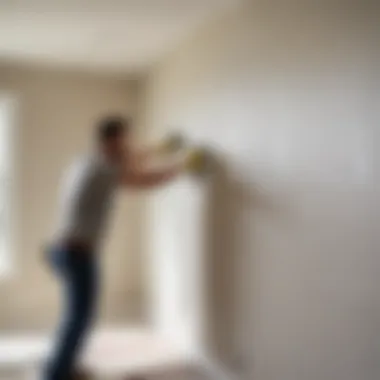Preparing Drywall for Wallpaper: A Complete Guide


Intro
Проектирование и планирование
Как выбрать проект для DIY
When beginning a wallpaper project, it is crucial to choose a design that complements your space. Understand the style of the room and how different wallpaper patterns can influence its mood. Consider browsing through various design sources, such as interior design magazines or websites like Pinterest or Reddit, to visualize what you want. Once you select a design that appeals to you, ensure it fits well with the dimensions and lighting of your space.
Оценка времени и ресурсов
Time management is another vital aspect to consider. Preparing drywall can take anywhere from a few hours to a couple of days, depending on the condition of the surface. Assess your schedule and allocate enough time for proper preparation, which may include cleaning, patching, and sanding the drywall. Make a list of all required resources, such as tools and materials, to prevent last-minute runs to the store.
Выбор материалов
Типы материалов для различных проектов
Choosing the right materials is essential for a successful wallpaper application. Different types of wallpapers, such as vinyl, paper, or fabric, have specific requirements for installation. For example, vinyl wallpaper can be more forgiving when it comes to imperfections on the wall, while paper wallpaper may require a perfectly smooth surface. Evaluate your options based on the design choice and room functionality.
Советы по покупке и экономии
To maximize your budget, consider buying materials from local suppliers or online marketplaces. Always compare prices and read reviews to ensure quality. Buying in bulk can also reduce costs; when planning a larger project, consider purchasing extra wallpaper in case of mistakes or future repairs. Always keep an eye on sales or discounts that might be available.
"Proper drywall preparation is the foundation for a successful wallpaper installation, making all the difference in the result."
The detailed process of preparing drywall will follow, covering each step necessary to guarantee optimal results and address common issues. The information gathered here lays the groundwork for a proficient and successful wallpaper application.
Prelude to Wallpapering Process
When it comes to enhancing interior spaces, wallpaper remains a popular choice due to its versatility and aesthetic appeal. This section emphasizes that a successful wallpaper application relies heavily on proper preparation. The state of the drywall directly impacts the wallpaper's adhesion and overall appearance. Proper preparation can prevent numerous frustrations during the wallpapering process.
Understanding Importance of Preparation
The preparation of drywall before applying wallpaper cannot be overstated. A smooth, clean surface ensures the wallpaper adheres properly, minimizing the risk of bubbling or peeling in the future. Variations in texture or imperfections can disrupt the visual flow and lead to unsightly results.
Moreover, preparation allows you to identify any underlying issues. This can include existing damage, moisture problems, or substandard materials that, if not addressed, could compromise the entire project. Ensuring the drywall is in good condition adds to the longevity of wallpaper and reduces the chances of later complications.
By paying attention to these preparatory steps, one sets a solid foundation for successful wallpaper installation.
Common Mistakes in Wallpapering
Many individuals often encounter common mistakes that can derail an otherwise straightforward process.
- Neglecting Surface Preparation: Some may assume that wall imperfections are insignificant, but this is a misconception. Not sanding or priming the wall adequately can cause peeling or bubbling.
- Improper Measurement: Failing to measure the wallpaper and walls accurately can lead to wasted materials or mismatched patterns.
- Ignoring Condition of Drywall: Overlooking the state of the drywall, such as cracks or water damage, can result in significant issues down the line.
- Using Incorrect Adhesive: Choosing the wrong type of glue can also lead to problems with adhesion, particularly on certain drywall types.
By avoiding these mistakes and focusing on preparation, individuals can save time, resources, and effort. Addressing these aspects from the beginning ensures that the wallpaper not only looks good but lasts much longer.
Identifying the Right Drywall Type
Identifying the right drywall type is critical in the wallpaper application process. Different types of drywall have unique properties, and understanding these can greatly influence the final outcome. It affects not only the adhesion of the wallpaper but also the overall durability and appearance.


When considering drywall, one should account for factors like moisture resistance, texture, and thickness. Selecting the appropriate drywall ensures a solid base for wallpaper, helping to prevent issues such as peeling or bubbling once installation is complete. Knowing the specifics of each drywall type can aid professionals and DIY enthusiasts alike in making informed decisions.
Types of Drywall Suitable for Wallpaper
There are several types of drywall, each with its own set of benefits:
- Standard Drywall: This is the most common type, suitable for most interior spaces. It consists of gypsum plaster sandwiched between two sheets of heavy paper. It provides a decent surface for wallpaper but requires proper priming and preparation.
- Moisture-Resistant Drywall: Also known as green board, this type is treated to resist moisture and is ideal for use in kitchens and bathrooms where humidity is common. Wallpaper can be applied, but ensuring it's done correctly is essential to avoid any future issues.
- Fire-Resistant Drywall: Often used in commercial settings, this drywall type has added materials to improve fire resistance. It functions well under specific conditions. However, its use in residential wallpaper applications is generally not necessary unless local building codes dictate its requirement.
- Soundproof Drywall: This variety is designed to minimize sound transmission. If noise control is a concern, selecting this drywall type could be beneficial. Wallpaper adheres well, but additional steps may be required to ensure a smooth finish.
Understanding the characteristics of these drywall types can help one to avoid potential pitfalls. Using suitable drywall improves both the aesthetics and longevity of the wallpaper application.
Assessing Drywall Condition
Before proceeding with wallpaper application, it’s essential to assess the condition of the drywall. A thorough inspection can uncover underlying issues that might hinder a successful wallpaper installation.
- Check for Damage: Identify any cracks, holes, or dents on the surface. Even small imperfections can compromise the adherence of the wallpaper. Where necessary, repairs should be made before applying any further preparations.
- Inspect Moisture Levels: Excess moisture can lead to molding and weakening of the drywall. Testing for moisture can help avoid future complications. If the drywall shows signs of moisture damage, it may need to be replaced or thoroughly dried out.
- Evaluate Surface Smoothness: The surface must be smooth for the wallpaper to adhere properly. Any bumps or ridges can result in a textured appearance that is often undesirable in finish.
- Ensure Proper Installation: If the drywall was not installed correctly, this might present challenges for wallpapering. Misalignments and gaps should be addressed to ensure a flat surface.
This assessment needs to be comprehensive, as it can save time and resources in the long run. Properly evaluating the drywall condition sets the stage for a successful wallpaper installation, leading to professional-looking results.
Surface Preparation Techniques
Preparing the drywall surface is a crucial step in the wallpapering process. It establishes the foundation on which the wallpaper will adhere, significantly influencing the overall finish and durability. A well-prepared surface ensures that the wallpaper lays flat without bubbles or peeling. Ignoring this step can lead to complications during the application and affect the appearance long-term. Proper cleaning, repairing, and sanding of the drywall are vital methods to achieve optimal results in wallpapering.
Cleaning the Drywall Surface
The first step in any preparation is cleaning the drywall. Dust, dirt, and grease can hinder the adhesion of the wallpaper. A clean surface allows for better contact between the wallpaper and the wall, reducing the chance of future peeling.
To clean effectively, follow these steps:
- Dust Off: Use a dry cloth or a vacuum with a brush attachment to remove loose dust from the surface.
- Wash the Surface: Prepare a solution of mild detergent and warm water. Using a sponge, gently scrub the drywall surface. Avoid using excessive water as it can damage the drywall paper.
- Rinse: Wipe the surface with a clean, damp sponge to remove soap residue.
- Dry: Allow the wall to thoroughly dry before proceeding to the next step.
This process not only cleans but also allows for inspection for any damage that might require further attention.
Repairing Cracks and Holes
Before applying wallpaper, it is essential to address any imperfections in the drywall. Cracks and holes can compromise the look of the final product if not properly repaired. The aim is to create a smooth, even surface.
Here’s how to repair:
- Assess Damage: Identify any holes or cracks in the drywall. A simple visual inspection is often sufficient.
- Fill Holes: For small holes, use a spackling compound. Apply it with a putty knife, pressing into the hole to fill completely. For larger holes, use a joint compound or patching compound.
- Repair Cracks: Apply joint compound using a putty knife, pressing firmly into the crack. Smooth it out so it aligns with the surrounding surface.
- Drying Time: Allow the repairs to dry completely. Follow manufacturer instructions regarding drying times. This is critical to ensure the integrity of your repairs.
- Check for Imperfections: Once dry, touch up as needed and ensure that the repaired areas are level with the rest of the wall.
Sanding the Surface
Sanding the repaired areas is often necessary after the compound has dried. This step helps to create a seamless surface that is ready for wallpaper. Without sanding, irregular surfaces can cause wallpaper to bubble or wrinkle.
The sanding process entails:
- Select Sandpaper: Use fine-grit sandpaper, typically around 120 to 220 grit. This will smooth the surface without creating deep grooves.
- Sanding Technique: Sand gently in a circular motion or along the grain until the surface feels smooth to the touch.
- Dust Removal: After sanding, remove the dust with a damp cloth or a vacuum. This prevents dust particles from getting trapped under the wallpaper.
Applying Primer
Applying a primer to drywall surfaces is crucial in the wallpaper installation process. The primer serves multiple functions that enhance both the appearance and longevity of the wallpaper. Without a proper primer, wallpaper may not adhere well, which could lead to peeling or bubbling. This not only affects the aesthetic appeal but also the overall durability of the wallpapered surface.


The benefits of applying primer include improved adhesion, a more uniform surface, and prevention of moisture issues. A well-primed surface mitigates the risk of the wallpaper absorbing drywall dust or imperfections, ensuring a smoother application. Additionally, primer can act as a barrier against any residual contaminants that may be present on the drywall, thus protecting the wallpaper from possible damage over time.
Considerations when applying primer include the type of drywall, the condition of the surface, and the type of wallpaper being used. Selecting the correct primer tailored to these specific factors is essential for achieving optimal results. This section will explore how to choose the right primer and the recommended steps for effective application.
Choosing the Right Primer
Selecting the correct primer is a fundamental aspect of preparing drywall for wallpaper. There are several varieties available, each suited for specific conditions. For standard drywall, a latex-based primer is generally sufficient. This type promotes adhesion and works well with a variety of wallpaper types.
For moisture-prone areas, such as bathrooms, an oil-based or moisture-resistant primer is more suitable. These primers are designed to withstand high humidity levels and help prevent mold or mildew development beneath the wallpaper. When choosing a primer, consider the wallpaper material as well; vinyl wallpapers may require a special adhesive primer to ensure proper bonding.
Some factors to consider when choosing the right primer include:
- Drywall Type: Different primers work best with different drywall surfaces.
- Moisture Levels: Areas with high humidity need special primers.
- Wallpaper Material: Ensure compatibility with the selected wallpaper type.
How to Apply Primer Effectively
Applying primer requires careful attention to detail to ensure an even coat. First, prepare the workspace. Remove any debris or dust from the drywall surface. Use a clean cloth to wipe down the area, ensuring a smooth application.
Next, gather the necessary tools such as a paint roller, a paintbrush for corners and edges, and an appropriate primer. It's important to stir the primer well before use to maintain consistency.
When you start priming, follow these effective steps:
- Edge Application: Begin by using a brush to apply primer along the edges and corners of the drywall to ensure complete coverage.
- Roll Application: For larger areas, use a roller to apply a uniform coat of primer. Work in sections, ensuring that each section overlaps slightly with the previously primed area to avoid streaks.
- Drying Time: Allow the primer to dry fully according to the manufacturer’s instructions. This step is crucial before proceeding with wallpaper installation.
- Inspect: After drying, inspect the surface for any missed spots or uneven areas that may require a second coat of primer.
Following these steps will greatly improve the wallpaper’s adhesion and overall appearance, laying a solid foundation for a successful installation.
Tools and Materials Needed
Essential Tools for Preparation
Several tools are integral to preparing drywall properly. Each tool plays a specific role in achieving a smooth surface and preventing future issues with the wallpaper. Here are some essential tools to consider:
- Utility Knife: This is used for cutting drywall and trimming excess paper or single-layer wallpaper. A sharp utility knife is crucial for clean cuts.
- Sanding Sponge: Sanding sponges are versatile and can reach corners and edges easily. They help to smooth rough areas after any repairs are made.
- Putty Knife: A putty knife is needed to apply joint compound to fill in holes or seams in the drywall. It is also useful for scraping away any imperfections.
- Drill or Screwdriver: These are required if screws need to be added or replaced on the drywall. A sturdy mount ensures the drywall stays in place.
- Paint Roller or Brush: For applying primer effectively, these tools are necessary. Using them increases coverage speed and improves the application quality.
Having the right tools allows for detailed work and minimizes the risk of damaging the drywall. Each tool should be selected based on its quality and suitability for the specific preparation task.
Materials Required for Effective Results
In addition to the tools, specific materials are crucial for preparing drywall. These materials support the surface quality and adhesion of the wallpaper. Here are some key materials to consider:
- Primer: A good quality primer helps seal the drywall and provides a better surface for wallpaper adhesion. It can also prevent the drywall from soaking up moisture from adhesives.
- Joint Compound: This is utilized for repairing seams, cracks, or holes in the drywall. Selecting the right type ensures durability and a smooth finish.
- Sandpaper: Along with sanding sponges, regular sandpaper is necessary for smoothing surfaces after repairs. The right grit levels aid in achieving a refined finish.
- Wallpaper Adhesive: Choosing the correct adhesive depends on the type of wallpaper being applied. It affects how well the wallpaper adheres and how easy it is to remove later if needed.
An appropriate selection of materials contributes not only to interior aesthetics but also to the longevity of wallpaper applications.
By being mindful of both tools and materials, one can streamline the preparation process, resulting in a successful wallpaper installation. Each choice made here is part of a larger strategy to create a beautiful and lasting finish.
Dealing with Common Drywall Issues
Dealing with common drywall issues is a critical phase in the preparation for wallpaper application. The state of your drywall can directly impact the outcome of your wallpaper project. Addressing issues like moisture problems and uneven surfaces not only saves time but also ensures that your wallpaper adheres correctly and looks aesthetically pleasing. Any oversight in this stage can lead to peeling, bubbling, or other forms of damage to the wallpaper.


Addressing Moisture Problems
Moisture is one of the most detrimental factors when it comes to drywall preparation. Excessive moisture can cause mold growth, which can ruin wallpaper and affect indoor air quality. First, inspect your drywall for signs of moisture damage, which often includes discoloration or soft spots. If you notice these issues, it is essential to source the cause of the moisture, which could stem from leaks in plumbing or roofing.
- Identify Sources of Moisture: Check for leaks, condensation, or humidity issues.
- Dry the Area: Use fans or dehumidifiers to eliminate excess moisture.
- Repair and Treat: Depending on the severity, consider repairing the drywall or applying a specialized treatment to prevent mold growth.
- Seal the Surface: Once dry, apply a moisture-resistant primer to seal any remaining moisture and protect the surface. This step is vital for long-lasting results.
Handling Uneven Surfaces
Uneven surfaces on drywall can create significant problems for wallpaper application. If your wall is not smooth, the wallpaper may not adhere properly, leading to installation challenges and an unprofessional appearance.
- Assess the Surface: Use a straight edge to determine where the uneven spots are.
- Fill Low Spots: A joint compound can be used to fill these areas. Apply it and let it dry properly before proceeding.
- Sand the Surface: Once the joint compound is dry, sand the area with a fine-grit sandpaper to ensure a smooth finish.
- Check for Texture: If the drywall has a texture that is problematic for wallpaper, consider applying a layer of joint compound over the entire surface to create a smooth finish.
Important Note: Always ensure the surface is dust-free after sanding to improve adhesion when applying wallpaper.
Preparing for Wallpaper Installation
Preparing drywall for wallpaper is a pivotal stage in the wallpapering process. This preparation not only sets the foundation for a visually appealing result but also influences the longevity of the wallpaper. If the surface is not adequately prepared, issues such as bubbling, peeling, and unevenness can arise, detracting from the overall aesthetic.
There are several key elements to consider during this phase:
- Ensuring a Clean Surface: Any dust, grease, or debris on the drywall can hinder wallpaper adhesion. Therefore, thorough cleaning is essential.
- Final Touch-Ups: It’s crucial to inspect for any imperfections, such as small holes or rough areas that may have been overlooked during earlier preparation stages. Addressing these issues is vital for a uniform application.
- Organizing Tools and Materials: Identifying and having all necessary tools and materials at hand will streamline the application process. This reduces frustration and sets a tone of efficiency.
- Mental Preparation: Understanding the upcoming steps, including the wallpapering technique and drying times, can lessen anxiety and promote better execution.
Ultimately, preparing for wallpaper installation can significantly influence the result. Investing time in this preparation pays off in enhanced aesthetics and durability, providing ample return on the effort spent.
Final Checks Before Installation
Before diving into the actual wallpaper installation, carrying out a final inspection ensures that everything is in place. This phase acts as a checklist to verify readiness. Here are the aspects to confirm:
- Surface Condition: Check for any leftover dust on the drywall and clean it again if necessary. Avoid compromising the state of your prepared surface.
- Drying Time: Ensure any primer or repair compounds applied earlier have fully dried according to manufacturer specifications. This can help prevent potential mishaps during application.
- Tools and Materials: Make sure to have all tools, such as brushes and application methods, as well as wallpaper rolls ready and easily accessible. This eliminates unnecessary interruptions.
- Room Environment: Assess the temperature and humidity levels within the room. Ideal conditions range from 50 to 85 degrees Fahrenheit, with moderate humidity. Extreme levels can affect adhesion and drying.
"Wallpapers adhere best under stable conditions, minimal temperature fluctuations will help to achieve optimal results."
A final check will reaffirm your preparedness. Take notes about areas that need special attention during application, and visualize the layout of the wallpaper. By doing these steps, you set yourself up for success.
The End and Recommendations
In any wallpapering project, the preparatory phase is critical. Concluding this guide, it is important to summarize the steps that ensure a successful application of wallpaper. Through diligent preparation of drywall, one enhances the durability and aesthetic quality of the wallpaper. This section reaffirms that neglecting drywall preparation can result in an unsatisfactory finish and potential removal of the wallpaper in the future.
By ensuring the drywall is clean, smooth, and properly primed, you create a solid foundation for wallpaper adhesion. Consequently, this underlines the benefits of investing time in preparation. The result is not just a pleasing visual outcome but also reduces future maintenance issues associated with peeling wallpaper or uneven surfaces.
Moreover, considering specific elements during this stage remains essential. Keep in mind the type of primer suitable for your wallpaper, as well as the tools needed. Take note to properly repair cracks and holes, ensuring a seamless surface. Addressing moisture problems is another key factor. Any oversight in these areas may lead to complications post-application.
Ultimately, careful planning improves not just the results of a single wallpaper project but also enhances your skills for future endeavors. By adhering to the recommendations provided throughout this article, your wallpapering projects can achieve a level of professionalism that reflects your efforts.
Summary of Key Preparation Steps
- Assess Drywall Condition: Check for damage, moisture, and any irregularities.
- Repair: Fill cracks and holes with appropriate materials. Allow to dry before proceeding.
- Sanding: Smooth any rough patches to create an even surface.
- Clean the Surface: Remove dust, grease, and debris effectively.
- Apply Primer: Use a primer that matches the wallpaper type, enhancing adhesion.
- Final Review: Inspect your work to confirm that everything is ready for wallpaper.
By following these steps, you ensure a suitable foundation for a long-lasting and visually appealing finish.
Advice for Successful Wallpaper Projects
Achieving success in wallpaper projects involves strategic planning and execution. Here are essential tips to keep in mind:
- Choose Quality Materials: Select wallpaper that suits your space in terms of durability and style.
- Use Proper Tools: Ensure you have all necessary tools at hand before starting. This includes utility knives, smoothing tools, and measuring tapes.
- Follow Manufacturer Instructions: Each wallpaper may have specific guidelines for installation. Always adhere to these.
- Consider the Environment: Proper room conditions, such as temperature and humidity, help with adhesive setup.
- Take Your Time: Rushing can lead to mistakes. Focus on each step to achieve a polished result.
By keeping these considerations in mind, your wallpaper installation will likely yield favorable results, enhancing the overall ambiance of your spaces.







